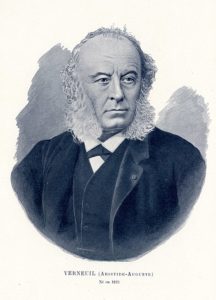Hidradenitis Suppurativa is the name we all know, but maybe not love. It turns out doctors might feel the same. Names are certainly more than labels, they are descriptions. However, HS doesn’t accurately describe the physiological process. As well as that, HS is not the only name for the condition. Today we are going to look at where the names for HS came from. And fun fact, the history of HS began with a misdiagnosis. Are you surprised?
A History of HS: Timeline
The history of the name HS begins with the plotting of the sweat glands. Initially, doctors thought the sweat glands were responsible for HS. But since the mid-20th century, we have learned more. We now know that blocked hair follicles play a role. The sweat glands are a secondary issue. But the name has stuck, and others have been coined since.
This is how it happened.
• 1833 – Dr Jan Evangelista Purkinje discovered the sweat glands. Physician Fredrick Velpeau found a boil-like condition which affected the genital, perianal and breast areas.
• 1845 – Anatomist, Robin plotted the structure and location of the sweat glands.
• 1854 – Aristide Verneuil, a French Physician, also observed the condition we now call HS
• 1865 – Verneuil coined the term Hidrosadneite Phlegmoneuse, French for HS. The location of the lesions led him to believe the cause might be the sweat glands.
• 1939 – Dr Henry A Brunsting published a paper claiming the apocrine glands were the primary source of HS.

Aristide Verneuil
13 year later, the hair follicle became the focus
• 1952 – Brunsting changes his theory to look at acne, which is caused by follicular occlusion.
• 1989 – Physician H. Hurley created the first classification system for HS. We know it as the Hurley Grading System.
In 2009 The HS Foundation adopted an internationally recognised definition of HS.
Velpeau’s & Verneuil’s Disease
Verneuil’s disease and Velpeau’s disease are both HS. These names refer to Velpeau and Verneuil who first studied HS. But as we know, this is not the name given to the disease by Verneuil. And I could find no evidence that Velpeau put a name to his observation at all.
Neither name is commonly used. But sometimes they are, especially in medicine. So it’s good to know what they mean. And of course, where they come from.
Hidradenitis Suppurativa
Hidradenitis refers to inflammation of the apocrine glands. Verneuil thought this may be the primary source of the lesions he observed. But he admitted this was only speculation, as he never tested his theory.
In the past fifty years, scientists have debunked Verneuil’s theory. We now know that follicular occlusion is a contributing factor in HS.
Follicular occlusion causes a set of skin conditions called “the follicular occlusion tetrad.” The hair follicle becomes blocked with keratin or bacteria. The blockage causes swellings which rupture and spread.
It is only after the wound ruptures the apocrine sweat gland become involved. As the name HS is based on a misunderstanding of the disease, some have argued for a change. And the most popular suggestion is Acne Inversa.
Acne Inversa
Remember the timeline? Brunsting found evidence for the involvement of the apocrine sweat glands in 1939. But in 1952 he changed his mind. He now thought that HS had a lot in common with acne.
In 1959, Pillsbury, Shelley and Kligman coined the term “follicular occlusion triad. The triad consisted of:• Hidradenitis Suppurativa
• Acne Conglobata
• Dissecting cellulitis of the scalp
And in 1975 Plewig and Kligman added pilonidal sinus to the triad making it a tetrad. All the conditions in the tetrad create tunnels through the layers of the skin. Thus, some researchers argue that the name HS should be changed to Acne Inversa.
But this is science, and others disagree. Furthermore, science is slow to change. And until we fully understand the cause and nature of HS, I don’t imagine there will be any changes to the name soon.
Did Karl Marx have HS?
While researching this post, I came across an interesting claim. Karl Marx wrote about a debilitating condition that caused boils to form on his body. And some researchers think that this mysterious illness was HS.
According to a 2007 paper, Marx wrote about different kinds of lesions in delicate parts of his body. He called them, boils, furuncles and carbuncles. And each looked different. As well as that, the lesions were recurrent and caused tissue damage around them.
How Far We’ve Come
But Karl Marx died in 1883, only eighteen years after Verneuil named the disease HS. And the working theory at the time was that HS was caused by the sweat glands. So, we will never know whether Marx’s condition was HS.
Moreover, just like now, skin lesions were a source of shame in the past. Most likely because so little was understood about them. Marx, out of embarrassment, only disclosed his condition to a few.
While we have certainly learned a lot in the past 187 years. However, we still have a long way to go. That being said, we have made great strides in HS research since 1833. We now have a grading system. We have treatments, and we are working toward reducing stigma. The future is bright.
About the Author

Shannon Sweeney is a psychology and sociology student from Ireland. She is also living with HS and has a keen interest in lifestyle, wellbeing, and Hidradenitis Suppurativa.


